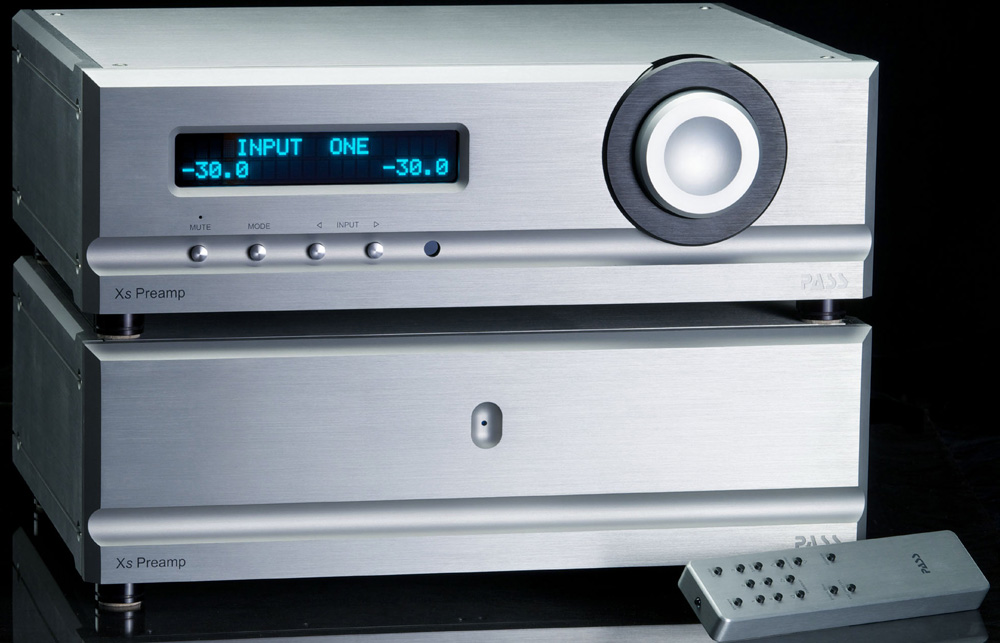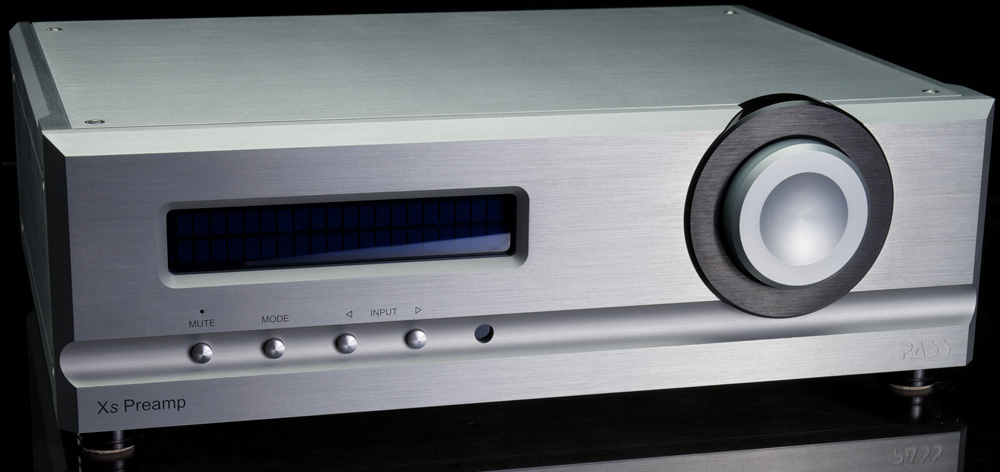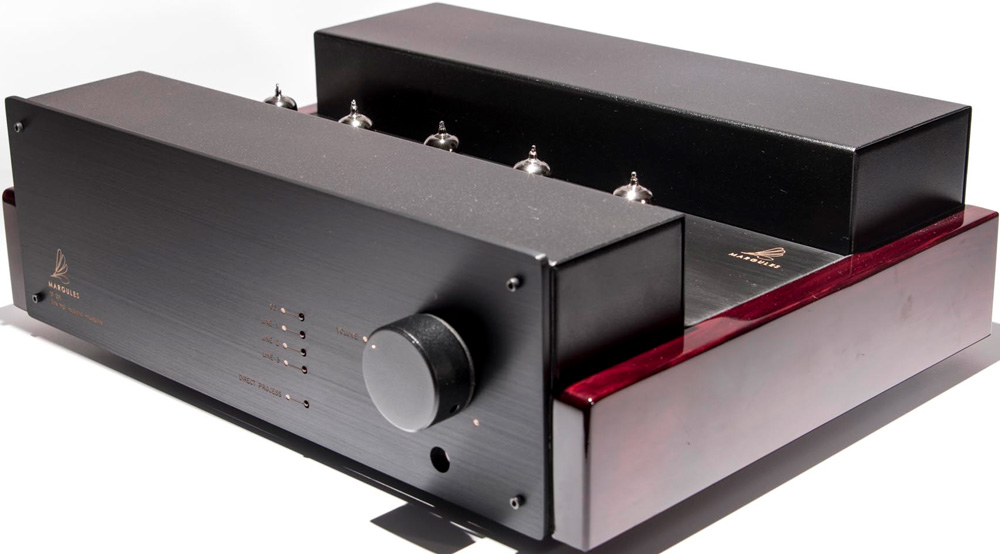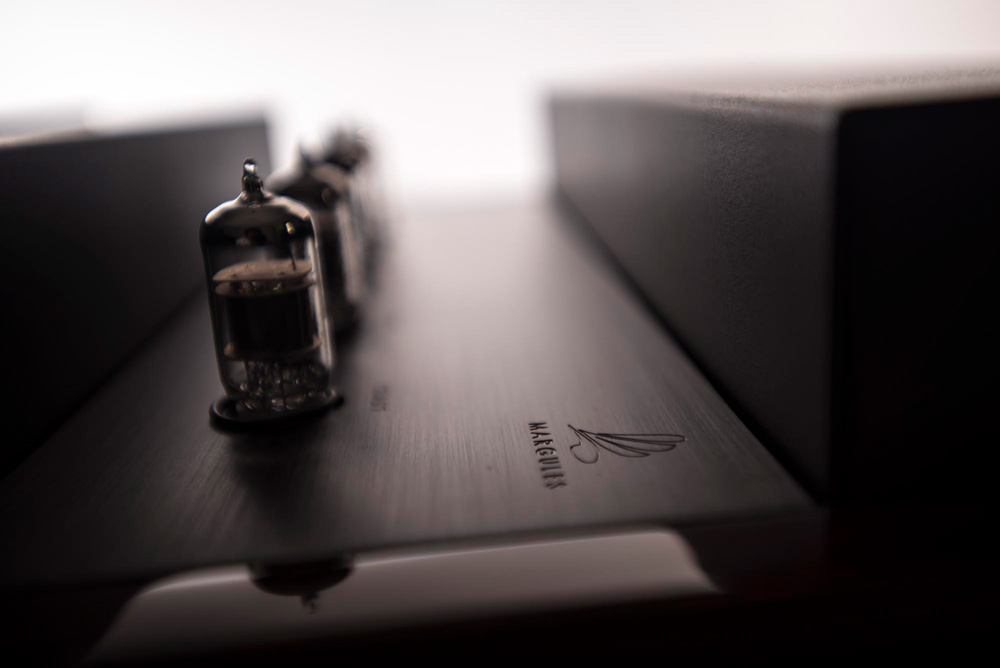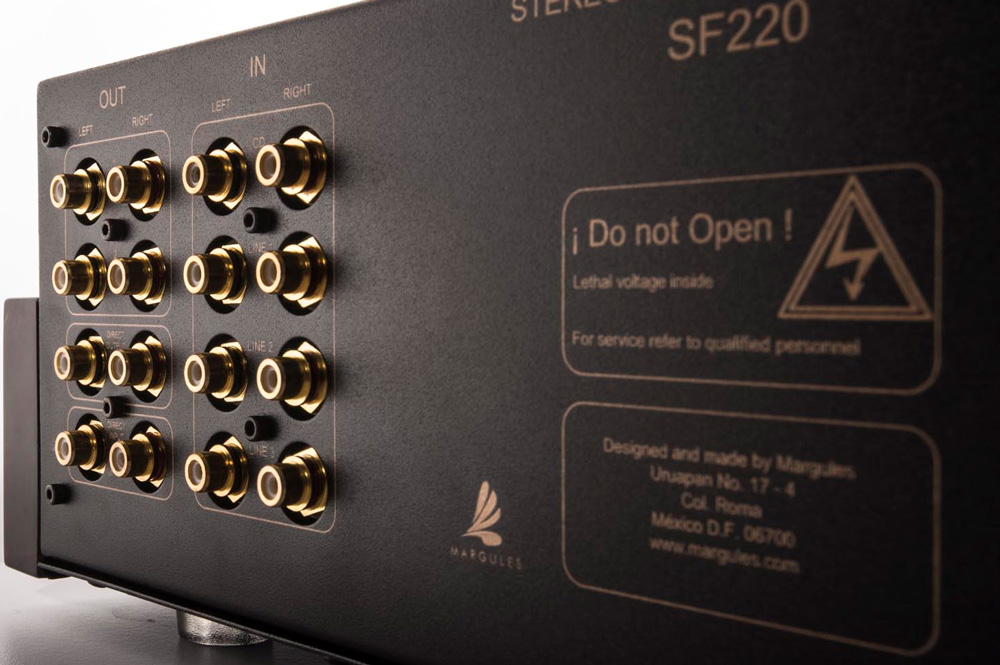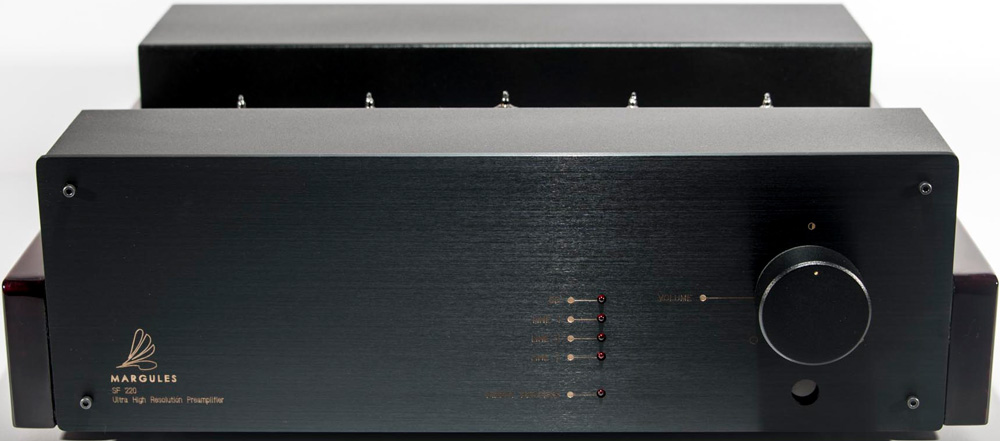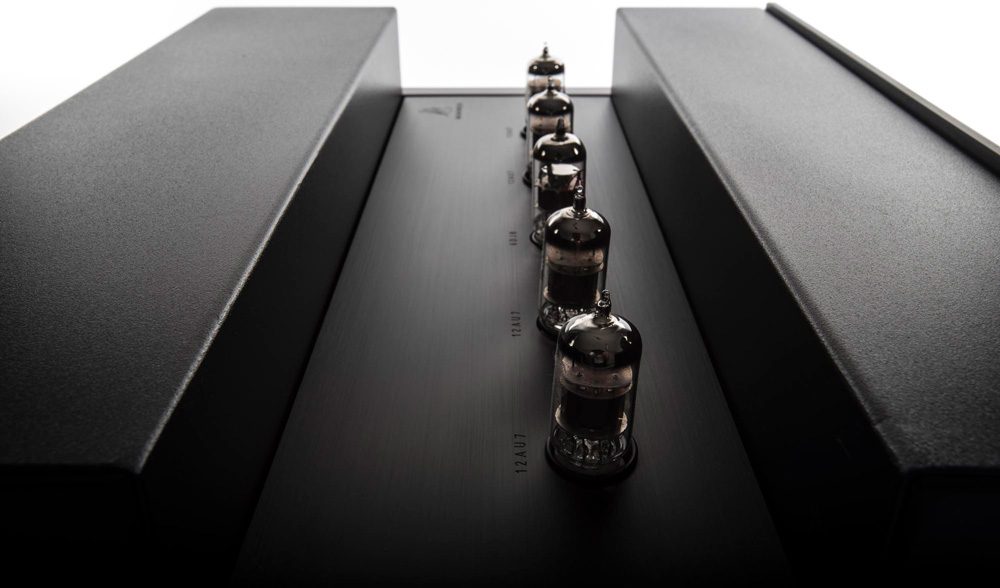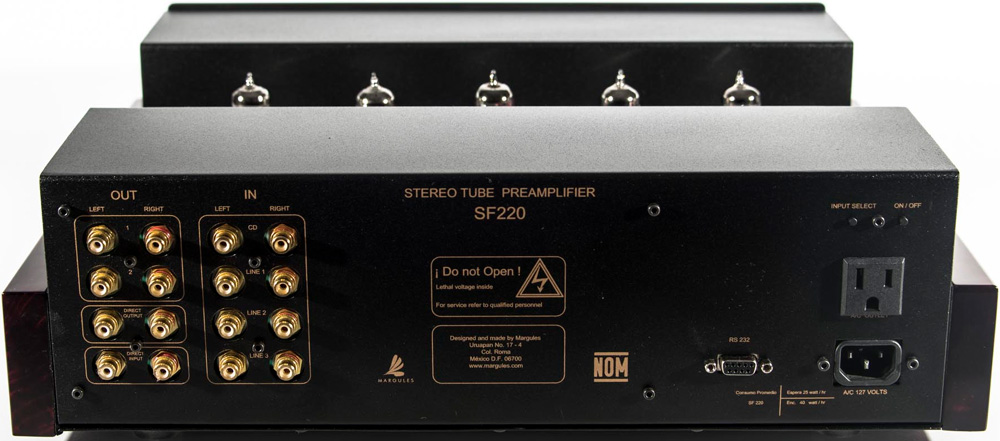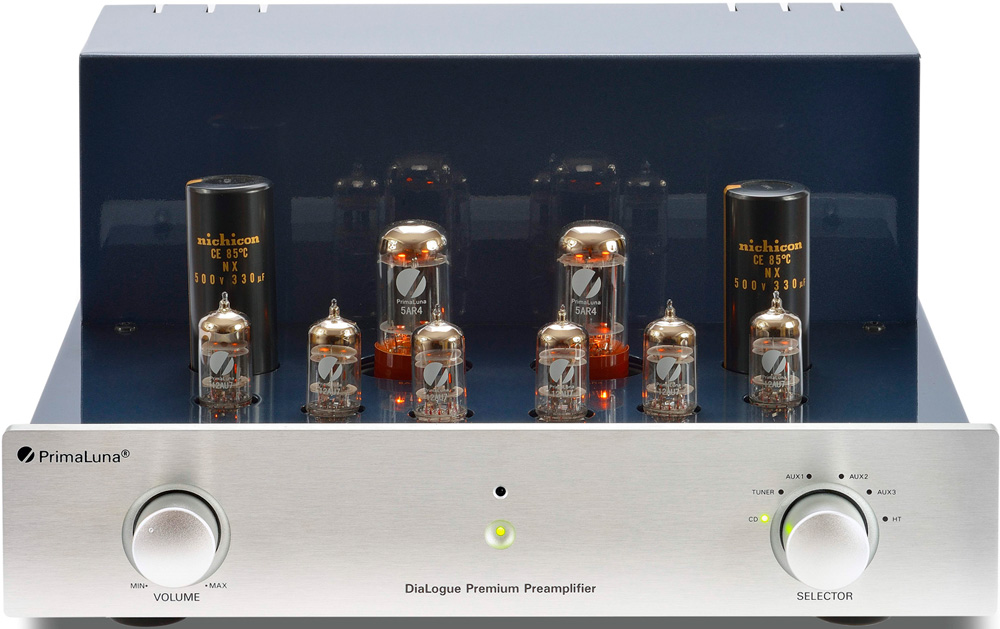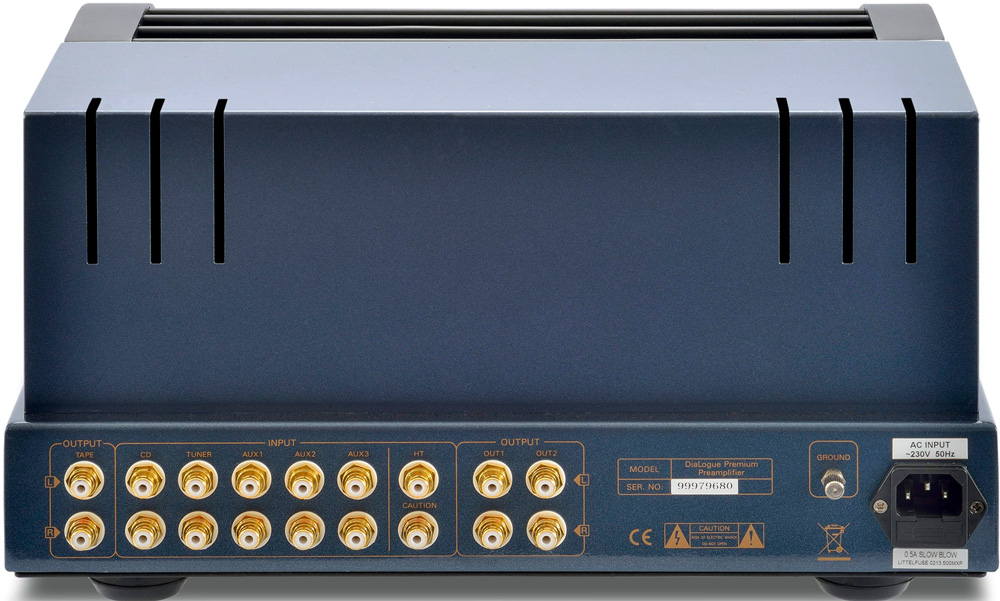![Sanders Preamplifier Sanders Preamplifier]() Slide rules and pocket protectors
Slide rules and pocket protectors
In the subjective audio universe, where gross amounts of 2nd harmonic distortion, horrendous phase shift, and totally inadequate frequency response gets euphemistically labeled “bloom” and “harmonic richness,” the purveyors of audio accuracy must hide their devotion to truthfulness like it’s a cardinal sin. “Zero phase shift?! Grab the matches and gasoline, we have a scientist in our midst.” There are negative connotations to marketing with specifications. Anyone old enough to have heard the first transistor amps will agree they sucked, regardless of what the specs said. Engineers in the ‘60s, ‘70s, and ‘80s, with their use of feedback as a blunt-force-instrument, forever tainted integrated circuits, feedback, and solid state. Though the equipment measured good, it sounded bad. Real bad. In a way, we should be thankful the big corporations made bad sounding equipment. Had they not, we wouldn’t have the audio underground and cottage industries that sprung up to satiate the appetite for good sound.
So, what’s wrong with electronics that have no audible distortion, no audible phase or frequency response issues, no oscillations, no noise and no problem driving any set of cables or amps or speakers? Nothing. Nothing is wrong with that. Are you so hung up on tube rolling and tweaking that you reject the hypothetical existence of an integrated circuit that would do a better job, and keep doing it the same way for 20 or 30 years? Are you that afraid of your music collection?
Though I admit to enjoying tubes, analog, open reel tape, and single driver loudspeakers, I will be the first to admit that there are significant limitations with all the above. If the primary job of an audio system is to be truthful, then does the current crop of high performance digital, and high performance integrated circuits deliver the goods? Increasingly, the answer is yes. We are advancing the state of the art in baby steps. Some of the advancements come from improved manufacturing techniques, giving us higher performance through better matched transistors and purer materials. Some of it has been new ways to accurately measure distortion, or the discovery that the ear can hear things that are hard to measure with simple harmonic distortion analyzers. Some of it is trickling down from medical, aerospace and military technology. The same circuits used to hunt down submarines or find tiny tumors have applications in audio. Billions of dollars have been spent to beat the competition, whether it is another chip manufacturer, stage IV cancer, or enemy combatants.
For all audio, I ask a few simple questions. Is the frequency response wide enough, and flat enough, to allow us to hear all the fundamentals and overtones, and in the correct relationship? Is there audible distortion? Does it have enough power to avoid clipping? After those criteria are met, can it recreate an acoustic space (imaging)? Finally, is it reliable? Those criteria are hard to satisfy, and when a piece meets the criteria, it usually satisfies musically. Sure, there are very subtle nuances, almost impossible to measure, that are the difference between the good and the great, but I have a hard time hearing those nuances over audible harmonic distortion and hum. Almost all the equipment I’ve reviewed had issues, usually minor ones, in one or more categories. Some people don’t mind scads of harmonic distortion, limited power or limited bandwidth, and you know who you are. I do mind, but there is a niche product for everyone.
The Goal
So, what has that to do with the latest preamplifier from Sanders Sound Systems? Everything. Roger is an actual engineer, in an industry with many “gurus” and copycats. Let me offer a few interesting excerpts from the Sanders website in the following:
“Our previous preamps (line stage and phono) were $4,000 each, for a total cost of $8,000 for our customers who needed a phono preamp. Since both preamps are now combined, customers who need a full-function preamp can now save several thousand dollars as the new preamp sells for half the price of the previous two.
The goal of a true audiophile grade preamplifier is to offer gain, switching, and other conveniences, while at the same time passing the original signal downstream without adding distortion, noise, or a sonic signature of its own. The Sanders Preamp does exactly that but includes many ergonomic features for convenience and ease of use that are not available on even far more expensive preamps.
The levels of each individual input can be adjusted to get them all matched so that you don’t get “blasted” or have to turn up the main level each time you switch sources. A stereo/mono switch remains standard equipment. The overall gain, individual gain between devices, and channel balance can be adjusted in precise, 1 dB increments. Muting by remote control is standard. A video readout makes it easy to monitor the levels.
… Front panel controls are done through micro-touch electronic switches. Internal switching is done by miniature, sealed, gold relays. Conventional rotary volume controls have channel matching error of around 20%, which causes the left/right balance to shift as you change the level. To solve this problem, some preamp manufacturers use discrete, precision resistors on a multi-step switch.
While this solves the channel tracking problem, they introduce new ones. Specifically, they have very limited resolution due to too few steps (typically 31 steps of 2 dB each). These “stepped attenuators” produce very annoying switching transients at each step.
The Sanders Preamp solves these problems by using the “volume control” knob to drive an optical comparator circuit. The optical circuit operates a microprocessor that controls an electronic gain system. This controls the level using one hundred, one dB steps, with precision of greater than 0.1% between channels.
The microprocessor monitors the signal voltage and waits for it to cross the zero voltage point between waves before switching to the next level. This prevents any switching transients. The volume control knob has detents at each 1 dB point and it rotates continually. So it as an infinite number of detents and you can feel each 1 dB change in level.
There is a digital display with beautiful, blue, light emitting diodes (LEDs). The display continually shows the output level of the unit and switches automatically to show level differences between channels, when you adjust the balance, or when you adjust the input levels. You no longer have to guess at the levels or try to see fine gradations on a knob to know the levels, since you can see them from several feet away.”
The heart of the new preamp is an extremely sophisticated chip that matches the gain to within .1dB and can remember the various level adjustments for each input. I asked Roger to elaborate:
“The volume control in my preamp is an electronic level control designed and manufactured by Burr-Brown (now owned by Texas Instruments). This chip has many excellent features. It is actually built like a stepped attenuator (using 400 microscopic resistors to obtain 200, 1/2 dB steps, in stereo).
The accuracy of the channel balance is determined by the precision of the resistors. Modern chip-manufacturing technology can now produce resistors with tolerances of better then 0.1% — which is far better than discrete resistors, which are limited to about 1%. Therefore, these Burr-Brown chips offer essentially perfect channel balance.
Conventional stepped attenuators often make “pop” sounds as the circuit changes to different resistors. This is due to the short delay as the switch moves to the next set of resistors, and during this delay, the voltage from the music changes. If the voltage change is significant, you will hear a “pop” when the next contact is made.
The Burr Brown chip solves this problem by constantly monitoring the voltage of the signal. When a change in volume is requested, the electronic resistor switching circuit waits until the voltage monitor shows that the voltage crosses the zero point. It then switches. Since there is no voltage present when the next step in the chain occurs, there is no “pop.”
Of course, music is changing voltage very rapidly, so any delay only lasts a few microseconds at worst. As a result, no human can detect any delay in the process, even when switching through the resistors very rapidly.
The chip has a video driver circuit so that I can have it show its levels on an LED digital display. It also has a microprocessor so that it can be programmed to operate in many different ways. It includes an opamp so that the gain can be controlled.
In my preamp, I control the microprocessor using an optical comparator “pot.” Therefore there are no conventional analog potentiometers to wear out and fail. This also makes it possible to operate the unit by remote control.”
The rest of the preamp includes input and output buffers (discreet) along with regulators. The parts quality is excellent including silver mica caps for the RIAA, Mills wire wound resistors and Mundorf caps. The thickness and quality of metal work are first rate: The top cover of the preamp is very heavy, good for damping vibrations and blocking EMI/RFI. Everything is of very high quality, whether a passive device, cutting edge integrated circuitry, potted toroidal transformer, faceplate, controls with good tactile “feel”, etc. All the components are mounted on one board, with a minimum of connectors and wires that would add noise.
I’ve been researching the dreaded op-amp lately, and it’s kind of a blanket term that should be avoided. You should rather think “integrated circuit”. When I asked Roger about using ICs he responded this way:
“Of course, audiophiles generally believe that ICs sound horrible. Like most audiophile beliefs, this is a myth. The truth is that modern ICs easily outperform any discrete circuit.
If you doubt that, just look at the IC’s measurements and specifications. Don’t believe the specifications? Then listen to ICs using valid listening tests. You will quickly discover that they sound absolutely transparent and that you cannot hear any difference between a modern IC and the perfect reference (a short, straight piece of wire)… I have abandoned discrete circuits like I used in my dedicated phono preamp because they simply could not match the performance of a modern IC.
This should not be surprising. After all, there is no magic. A transistor is a transistor regardless of where it is housed.
A transistor is really just a triode in a solid state. Specifically, its emitter is like a tube’s cathode (heater) in that it is the source of electrons that produce the current through the device. The collector is like a tube’s anode (plate) in that the electrons are gathered there and the current flows out of the transistor from that point. The base is like a triode tube’s grid in that it controls the number of electrons that flow through the transistor.
In a discrete transistor, the junction where all the activity occurs is microscopic. The vast majority of what comprises the visual transistor is just the package that holds the junction. The junction is built on a silicon wafer.
In an IC, transistor junctions are laid down on a silicon wafer, just like in a discrete transistor. The only difference between an IC and a discrete transistor is that an IC usually has many transistor junctions, it has circuit traces that connect those transistors. Additionally the resistors and capacitors that are required for the circuit are also produced on the same chip. As a result, you can have a miniature version of a PCB that contains many components.
There is inherently no difference between a PCB circuit and an IC, as all the same parts and circuit is used. However, the IC will be vastly smaller, usually better designed, and it will be absolutely consistent. As a result, it will generally out-perform discrete circuit designs. And an IC is a whole lot cheaper than building a discrete circuit — especially if that circuit uses tubes.”
One thing to remember is this: All ICs are not created equal. Every manufacturer makes chips for specific applications, though many use the similar circuits and architecture, like differential inputs, cascodes, even folded cascodes, long-tailed-pairs, etc.. Most circuits are direct coupled, so no lossy coupling capacitors. The difference from one chip to another is how they are “tuned” for a specific application.
Some applications like “down hole” applications, which are for the oil and gas industry, require “bullet proof” chipsets. You don’t want to pull one mile of pipe out of the ground because a $1.50 chip burned out. So, the manufacturer compromises some aspects of performance to give much higher reliability. Think of it like this: Ford makes trucks and they make cars. Trucks don’t handle like cars and cars can’t carry as much cargo as a truck. It’s the same thing with chips.
Once you look at premium chip sets from manufacturers like Texas Instruments, you realize that some are not cheap. The truly high performance chips are manufactured to very tight tolerances in clean-room environments. To get very low levels of noise, high gain, and bandwidth up to the gigahertz region, the complimentary transistors on an IC must be as closely matched as possible. This kind of quality costs significant money (ten to twenty times the cost of most “so-so” op-amps). Some of these chipsets cost over $15 each, in orders of 1,000. That means the cost for a few dozen will be significantly higher. Manufacturers have spent billions creating the technology, processes, and manufacturing facilities to make nearly perfect chips. So, chips aren’t created equal. Even the exact same circuit, built by different manufacturers, will give different results. It pays to buy quality parts, even if they are integrated circuits.
One thing Roger didn’t mention is this: If you take ten transistors and pack them on an IC, you are avoiding the inductance of the individual legs, the noise and distortion added when you solder a leg to a circuit board (because solder is a poor conductor compared to copper), just for the signal to be forced down a PCB trace, through another glob of solder, up the leg of another transistor, and into the transistor body. Just imagine you are an electron, trying to jump through all those different materials. It adds up to audible noise and distortion. Miniaturization eliminates losses by directly connecting one transistor to another, all in the same package. The result is lower distortion, higher bandwidth, higher slew rate, and inaudible noise. I’ve seen noise figures of 0.85nV/√(Hz), which is below the noise floor of all but the most extreme test setups, using equipment that costs as much as a modest house.
Find me a discreet circuit with 0.85nV noise figures, large signal bandwidth of 1.2 Gigahertz, and 3rd-order Intermodulation Distortion at -102dB; I don’t think you can. If you go back forty years and look at early op-amps, they don’t compare at all. It’s like comparing a Model T to a Ferrari 458 Italia.
Am I sold on the efficacy of modern integrated circuits? Yes. Just remember that it’s up to the designer to pick the correct chip for the job, and that a great chip can’t make up for other problems in the product. I might add that some of the chips and resistors are made in the US, if I am correct (I might be wrong).
The break-in period of the preamp lasted about a week. Roger and I disagreed about this. He feels that break-in is mostly in my imagination, but electrolytic capacitors do change some during the first few hours. To me, it sounded like the ESR of the capacitors gradually improved during the first three or four days, then stopped changing within the week. After that first week, I heard no further changes in sound. The improvements were a lower noise floor and better micro-dynamics. In other words, details were more obvious after the break-in period. It wasn’t a dramatic change, though.”
The sound of what?
The Sanders Preamplifier is a piece that many reviewers will hate, because it doesn’t have much sound of its own. Cartridges and speakers are easy to review. All mechanical transducers have ridiculous failings, though we are accustomed to those artifacts. Electronics, though, can be difficult to describe, and the Sanders Preamp (and the rest of Sanders electronics) is near the top of the list. It’s hard to describe any peculiar sounds or character produced by the Sanders Preamplifier.
So, what does it sound like? As a preamp, it has zero noise, and zero audible distortion. Whatever distortion is there, is so low that it’s impossible to point to it and say “A-Ha”! Take, for example, the fine tube preamp from Melody that I just finished reviewing. While I loved the looks and sunny disposition, it wasn’t as quick as the Sanders, plus it had audible 2nd harmonic distortion, audible noise and phase shift. Many listeners might not notice these but if you switch between the Sanders and Melody preamps, and if your speakers have good frequency extension, you can hear the difference. Plus, the Melody doesn’t have the perfect channel-to-channel match and volume tracking of the Sanders.
When I say perfect channel match and volume tracking, I mean it. This isn’t reviewer hyperbole. The volume tracking offered by the precision chipset gives .1dB accuracy, something a traditional volume control or unconventional transformer volume control can’t match. The frequency response of the two channels sounded indistinguishable: a nearly impossible feat by a tube preamp. Regardless of volume setting, the two channels were exactly the same. What that gives you is a world class center image “lock” and stereo spread better than anything I’ve used. In that regard, there might be products that are as good as the Sanders Preamplifier, but I doubt you’ll find anything audibly better. There might be other preamps with better imaging outside the speakers due to an even lower level of distortion or better transparency, but I don’t know of one; and it wouldn’t be because they had better volume tracking. It would be interesting to hear the Sanders compared to other transistor preamps using a similar volume control setup. I’ve always heard similar strengths when comparing transistor with tube pieces, but this preamp takes it to a new level.
Wax on…
The phono stage is as accurate, tonally, as any I’ve heard. There are hundreds of phono stages that have enough RIAA accuracy that I expect all phono stages to be similar. If they aren’t, it’s because the designer goofed. I’ll argue that perfect RIAA deemphasis is a waste of time, for a number of reasons that will make up a separate article of the subject. But, it’s not a bad thing to be accurate to less than a dB. What is more audible and more important is matching the EQ of the two channels. It’s the Achilles heel of tube phono stages. The Sanders LP playback channel-balance is as good as other transistor units.
When compared to tube phono stages, mono records don’t sound as smeared, left-to-right. Playing back mono records with tubes can give you a misshapen center image, with the highs stretched to one channel, the mids to the other channel, and the bass back to the other channel, making them sound like they were recorded in a house of mirrors. With the Sanders, mono records were locked in the center. I recommend using the mono switch if you are using a stereo cartridge to play mono recordings. Stereo cartridges will smear mono images for a number of reasons: skating forces, unequal coil windings, cartridge misalignment, warps and off-center pressings. Also, if it’s a mono recording cut with a stereo cutter head driven by stereo electronics, the two channels will be slightly different because cutting heads aren’t perfect; the cutting electronics and tape machines aren’t perfect either. Roger should be thanked for including the mono button. Thanks Roger.
There is enough flexibility in cartridge loading and gain to make a good match for the majority of cartridges. Is it my favorite? Not quite, but it is more linear, with less noise, than my favorite phono stages. This comes down to personal preference because LP playback will never be as “perfect” as playing back a CD. There are too many variables with vinyl play that can affect the sound. The added noise and distortion of my favorite tube LCR phono stages might be covering up mastering deficiencies, cartridge mistracking and/or misadjustment, along with the possibility of complex interactions of cartridge, tonearm, tonearm cable and phono loading which serves to “enhance” the music.
Compared to my favorite LCR phono stages, the Sanders didn’t have as much image depth (see my caveat below), and large scale dynamics seemed to be slightly suppressed. There are records that sound better on the Sanders. There are records that sound better on a tube LCR. The odd thing is that there are records that sound better on the budget Rek-O-Kut Professional Moving Magnet Preamp and, on a few rare occasions, there are records that sound better on a Dynaco PAS, although the PAS is not accurate). What does it mean? Vinyl mastering and playback is as much art as science, so it cannot be “perfected.” I suppose a company could master and press the vinyl, then put together a package of cartridge, tonearm, tonearm cable, and phono preamp, comparing and tweaking things to sound as close to the master tape as possible, but I don’t know of any such setup.
Surprise! Better than no preamp at all?
I was taken aback by what the Sanders Preamplifier did for my CD and open-reel listening. My reel-to-reel player is a semi-professional unit, the TEAC 35-2B Tascam Series. It has the ability to play two track and four track tapes (7.5 and 15 IPS), and uses separate volume controls for left and right. I can, and often have, connected the tape player directly to the amp, using the tape deck’s volume controls in lieu of a preamp.
With every other preamp or integrated amp, I heard a definite improvement when running the tape deck directly into the power amp inputs. Well, not anymore. Somehow, the Sanders preamp was able to breathe life into the signal, with better dynamics, better imaging and better frequency response. If there was a loss of detail, it was totally swamped by other improvements. Is the Sanders preamp “a straight wire with gain”? No, it’s not quite that good, but it’s closer than other preamps I’ve heard.
The same improvements happened when listening to digital. I’ve never had better digital sound from my sources, regardless of setup. I think the explanation is this: The high input impedance of the preamp makes it a breeze for your source components to drive; the high current, low impedance outputs can “drive the shit” out of any amp you choose. Apparently, my CD player and tape deck couldn’t drive a tricycle down the driveway.
The problem is that most sources don’t have robust output stages. A few sources have what amounts to a preamp output stage built in, but most sources are inadequate. Exceptions include professional studio sources that use output transformers. Those suckers can drive tube amps to max output, and have headroom to spare. But, couple a tube professional open-reel tape deck with a transistor amp, and things might be different. The reason is simple: Tube electronics have higher output impedance, while transistor electronics have lower input impedance, sometimes leading to audible problems.
Closer!
The Sanders preamp is edging closer to the ideal “wire with gain”. In several ways it’s as good as I have heard in my system, and better than the majority of what I have heard in other systems. It does have a little sound of its own, but it’s very difficult to pin down what that sound is. It had fewer artifacts than all the passive preamps I’ve used, including a simple stepped attenuator and transformer volume control. The stepped attenuator caused losses in dynamics and soundstage depth. The transformer volume control had audible phase shift and limited bass.
The touchy-feely audiophile in me says that it has less color saturation than great tube preamps, but none of those units have the image width or the unmatched channel-to-channel tracking of the Sanders. And tube preamps have noticeably more noise and distortion, whether it’s “benign” distortion or not. Plus, the great tube preamps eat tubes like tic-tacs, so that you have to turn them off, so then you have to warm them back up to listen, and eventually the performance suffers when the tubes start to age significantly. With the Sanders, you can plug it in, turn it on, and leave it on forever.
Compared to my aural memory of other products, which is fickle (and fecal), it seems like the image depth isn’t as good as the image width. (Editing Phillip’s article does make me feel like a road-kill at times – the shock then I’m in pieces. -Pub.) On the other hand, could it be that the center image “lock” and image width are so good that it makes it seem like it isn’t as deep? I can’t say with confidence. It’s like saying a single driver speaker has great midrange. Well, it better have awesome midrange, because a 5” speaker is going to be challenged to do anything audible at 20Hz or 20 KHz. So when you listen to a world-class full-range system, you think “man those full range drivers had great midrange”, when in reality the full-range system didn’t have anything except for midrange. I wasn’t able to quickly swap in other preamps for comparison. Maybe it’s nothing; all in my imagination; my zeal to nitpick. Maybe there is a limitation. Do you follow? If not, don’t worry. Where else are you going to get expert reporting like this? (Again. -Pub.)
The Sanders’ large scale dynamics were fast and powerful, being the equal to anything I can think of. In fact, the dynamics overwhelmed the undersized power amps I used with the Sanders preamp. The little amps couldn’t handle the dynamic swings from my 45rpm jazz reissues, or dance records, or big orchestral scores. I doubt this preamp will find its way into systems with 3-watt triode amps, but if it does, you better have very efficient speakers or this preamp will wag the dog!
I have heard better micro-dynamics, in plucked strings, for example, from simple tube preamps and transformer volume controls, but at a cost. They couldn’t do the other things the Sanders can do.
The Sanders’ frequency response is adequate for music. I didn’t hear any problems with frequency response, whether steady state tones or dynamic ones. If someone ran into a microphone, it went “booooom”, if the cartridge mistracked on cymbals, I heard it clear as a bell (which might also mistrack). There is no excuse for limited bandwidth in a modern preamp or amp. After switching to really large speakers, bandwidth limitations are immediately evident with many recordings. This preamp was more capable than my speakers, which are plenty capable. The specs say 5Hz to 200KHz, and I can’t argue.
There are/were preamps that have more deep bass grunt, but generally coupled with a darkness that robs the music of life. I’m speaking of preamps from Krell, Spectral, Levinson, Boulder, etc, which might have changed significantly since I last heard them. But those older products were too dark and heavy, the main reason tubes became my reference. It would be interesting, though a pain in the ass, to have a preamp shoot-out: comparing the tonal balance, distortion, imaging and volume tracking of multiple high end transistor preamps. I’ll leave that up to someone with more time than sense.
I didn’t have balanced sources or amps to try with the preamp. I did use the balanced options when auditioning the Sanders 10b speaker system a while back. I didn’t hear a big difference between single ended and balanced options with the 10B system, and I doubt you’d hear a big difference with this preamp. There are some sources that sound worse when using the balanced outputs. The same can be said for amps with balanced inputs. It’s worth experimenting if you have the option to use both. Keep an open mind and use whatever sounds better.
So, does the Sanders technology serve the music? In my opinion, it does, because listening was thoroughly enjoyable, and I frequently was surprised by a new insight or detail, which is a good sign. This preamp might reveal faults in the rest of the system that need addressing, but that is a good thing if the result is better playback.
The Sanders Preamplifier is rather unassuming. It doesn’t have a separate power supply chassis or fancy knobs. The finish is good, but not flashy. The price is downright “cheap” compared to many competing products. When sitting next to one of Sanders’ big amps, it may look like an afterthought, but you would be wrong. Roger, the engineer, made the unit big enough to get the job done, but no bigger. Fancy enough to match the other electronics, but no fancier. This is a preamp, not a status symbol.
Considering the price and performance, I doubt you’ll find anything better without spending significantly more. Considering you can leave it on all the time, and it comes with a lifetime warranty, it’s an easy recommendation.
The post Sanders Preamplifier Review appeared first on Dagogo.






























